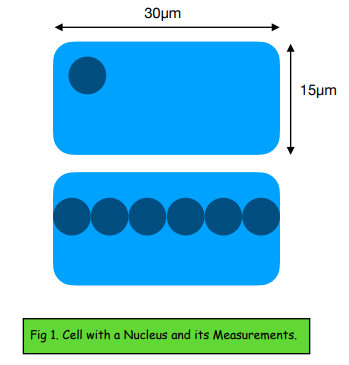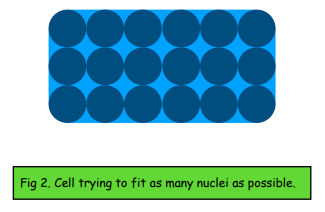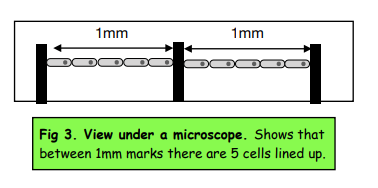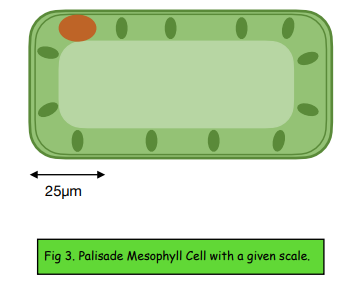Microscopes & Cultures - Cell Size and Area Estimations (GCSE Biology)
Cell Size and Area Estimations
Cell Sizes
- Plant cells and animal cells are larger than bacterial cells. A plant cell is between 10-100 micrometres long and an animal cell is between 10-30 micrometres long. A bacterial cell on the other hand is between 0.5-5 micrometres long.
Estimations
- Estimations can help you check whether your calculations are correct. Estimation is a rough calculation. You can round the numbers for example, to 1 significant figure, to help you do the calculation in your head and cross-check your calculated answer.
- Estimations can also be used to estimate the size/ area of subcellular structures that are too small to measure directly. You can use the known size of the cell and work out how many times the subcellular structure fits in the cell and use that to estimate the size/ area of the sub-cellular structure.
Example
Estimate the diameter of the nucleus:

You know the total length of the cell is 30μm. You can estimate the size of the nucleus as you know approximately 6 nuclei fit in the cell lengthways. Hence, you can estimate the diameter of the nucleus by doing the following:
30 / 6 = 5μm
Example
Estimate the area of the nucleus:

You know the length and width of the cell so you can work out the area:
30 x 15 = 450μm²
You can estimate how many nuclei will fit in the entire cell:
Approximately 18 nuclei will fit in the cell. So you can divide the cell’s area by the total number of nuclei to get an estimate of the area of a single nucleus:
450 / 18 = 25μm²
Measuring the Size of a Cell
The size of a single cell can be measured when observing cells under a microscope or if you are given a scale.
Microscope Slide Preparation
This involves taking a small piece of the tissue sample and placing it onto a small, rectangular piece of plastic/ glass called a microscope slide. The steps below outline how this should be done:
- Using a pipette, place a drop of water in the middle of the slide.
- Using tweezers, peel a small layer of your tissue sample and place it into the water droplet on the slide.
- Then, add a drop of a stain solution e.g. Iodine Solution. This will help stain the tissues and make them more visible under the microscope.
- Then place a square piece of clear plastic/ glass called a cover slip on top. Try placing the cover slip slowly by tilting in to avoid getting any air bubbles which could interfere and obstruct your view of the tissues.
- Place the prepared slide under the microscope and clip it onto the stage.
- Adjust the microscope settings to get a clear view of your specimen. If you are using a light microscope, you can adjust the following:
- Objective Lens – there are different powered lenses with different levels of magnification, you can choose which to use.
- Coarse Adjustment Knob – this moves the stage up and down, turn the knob to move the stage to just below the objective lens and look into the eyepiece to get the image roughly into focus.
- Fine Adjustment Knob – look into the eyepiece and turn this knob until you get a clear, focussed image.
Measuring Cells Using a Microscope
- Prepare your tissue sample and place it on your microscope slide.
- Place a clear ruler with mm readings on top of the slide and clip both the slide and ruler on the microscope stage.
- Select the objective lens with 100x magnification.
- Use the Coarse and Fine Adjustment Knobs to get a clear and focused image.
- Adjust the ruler so that the cells are lined up between the 1mm marks.
- Count the number of cells within the 1mm marks.
- Now calculate the length of an individual cell:

In this example, there are 5 cells in 1mm. So a single cell length would be:
1mm / 5 = 0.2mm
Now we need to convert it into μm. We know that: 1mm = 1000μm
So the length of a single cell in μm is:
0.2mm x 1000 = 200μm
Measuring Cell Area Using a Given Scale
You can calculate the area of a cell when given a scale.

- Use your ruler to measure the scale given in mm. For example, it might be 20mm.
- Convert to the correct units. 20 x 1000 = 20,000μm
- Calculate the magnification. Magnification = image size / actual size. 20,000 / 25 = 800
- Get the measurements of the cell. Length = 80mm, width = 40mm
- Convert the measurements into μm. Length = 80 x 1000 = 80,000μm. Width = 40 x 1000 = 40,000μm.
- Work out the actual size. Actual size = image size / magnification. Length = 80,000 / 800 = 100μm. Width = 40,000 / 800 = 50μm
- Work out the cell’s area. For example, using the above measurements, it would be: 100 x 50 = 5,000μm2
Drawing a Cell after Observing through a Microscope
There are certain rules that should be followed when doing biological drawings:
- Use a sharp pencil
- The drawing must take up at least half of the available space
- Make sure you use straight connected lines that aren’t broken and are clear
- Organelles such as nuclei should be drawn in proportion to the cells
- Label the important structures using straight lines that don’t crossover
- Don’t shade or use any colour in your drawing
- Include a magnification scale
- Make sure to title your drawing so it is clear what the drawing is
showing
A microscope is a scientific instrument used to magnify and study small objects or organisms, such as cells. Microscopes use lenses to magnify the image of the object being studied, allowing scientists to see details that are too small to be seen with the naked eye.
There are several types of microscopes, including light microscopes, electron microscopes, and scanning probe microscopes. Light microscopes use light to form an image, while electron microscopes use a beam of electrons to form an image. Scanning probe microscopes use a probe to scan the surface of an object and form an image.
Cell size and area estimation refer to the measurement of the size and surface area of cells. This information is important for understanding the structure and function of cells, as well as for studying cell growth and division.
Cell size and area can be estimated using a microscope by measuring the dimensions of the cell, such as its length and width. This information can then be used to calculate the cell’s surface area, volume, and other parameters.
A culture is a group of cells that are grown in a laboratory under controlled conditions. Cultures are used in biology to study the growth and behavior of cells, as well as to test the effectiveness of drugs and other treatments.
There are several types of cell cultures, including monolayer cultures, suspension cultures, and organ cultures. Monolayer cultures contain a single layer of cells growing on a flat surface, while suspension cultures contain cells that are suspended in a liquid. Organ cultures contain cells that are grown in a three-dimensional structure, mimicking the structure of a whole organ.
Cell cultures can be used to estimate cell size and area by growing cells under controlled conditions and using a microscope to observe and measure the cells. This information can then be used to calculate cell parameters, such as surface area, volume, and growth rate.
Studying cell size and area is important in biology because it provides information about the structure and function of cells. This information can be used to study cell growth and division, as well as to understand the behavior of cells in response to different conditions and treatments. Understanding cell size and area is essential for advancing our knowledge of cell biology and for developing new treatments for diseases and injuries.





Still got a question? Leave a comment
Leave a comment